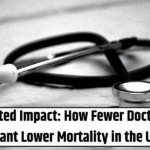BOLIGEE, Ala. — In Barbara Williams’ kitchen, a lone green light flickers on her wireless router, offering a feeble internet connection that rarely reaches beyond one bar. It’s just enough for the 72-year-old to occasionally scroll Facebook or check her daily devotional — but nowhere near strong enough for telehealth services or video calls with doctors.
Next to the router, Williams keeps a collection of medications, vitamin supplements, and a glucose monitor she rarely uses. Living with diabetes and nerve pain in both legs, she represents the many older Americans living in rural areas with limited access to both health care and broadband internet.
Williams is one of nearly 3 million Americans living in counties where medical providers are few and fast internet is even scarcer. According to a recent analysis by KFF Health News, such communities — concentrated largely in the South, Appalachia, and the rural West — experience higher rates of chronic illness and shorter life expectancy.
In these areas, the inability to access telemedicine or manage health through online portals often leaves residents isolated from the medical system. For Williams, whose nurse practitioner is based in a neighboring town, the concept of remote monitoring or virtual consultations feels unnecessary.
“I know my body,” Williams says. “If my sugar is up, I get a headache. If it’s low, I get weak. That’s how I can tell.”
Also Read – Republican Rep’s Medical Emergency Exposes Flaws in Florida Abortion Law
Still, experts argue that digital tools — especially for chronic conditions like diabetes — can improve patient outcomes. Dr. Rashmi Mullur, a telehealth leader at the VA Greater Los Angeles, says patients using virtual care are better able to manage their blood sugar levels. But without reliable internet, many rural residents are left behind.
Billions Allocated, but Many Left Offline
The federal government has poured more than $115 billion into broadband expansion efforts over the past decade. The latest investment, part of President Biden’s $42 billion “Internet for All” initiative from the 2021 Infrastructure Investment and Jobs Act, is aimed at closing the connectivity gap. Yet delays and political pushback — including Commerce Secretary Howard Lutnick’s recent order for a sweeping program review — threaten its rollout.
Meanwhile, over 200 counties continue to suffer from both medical and digital deprivation, particularly in communities marked by historic inequality and economic hardship.
“Telemedicine can bridge gaps, but without internet access, it just becomes another source of disparity,” said Dr. Mullur.
Williams lives in Greene County, where more than 25% of adults have diabetes — more than double the national rate. The county is majority Black, and like many such rural Southern areas, it suffers from limited broadband infrastructure and a shortage of medical professionals.
Despite the federal government’s new standards defining broadband as 100/20 Mbps — speeds capable of supporting multiple devices and streaming — Williams’ router barely offers a trickle of connectivity: download speeds under 0.05 Mbps.
A New Kind of Health Divide
A few miles from Williams’ home, a small beacon of modern care has emerged at the Boligee Community Center. The telehealth company OnMed, with support from local institutions and Starlink’s satellite internet service, has installed a booth where residents can receive free video consultations with doctors and check their vital signs. But even this high-tech setup is out of reach for many.
Williams recalled signing up at the community center for specially designed shoes to ease her foot pain. Months passed, but the shoes never arrived.
Inside her modest home, reminders of family history and faith surround her — from photos of siblings and grandkids to a large portrait of the Last Supper above the kitchen table. While she’s not fully engaged in digital care, she closely monitors her body’s signals, adjusting her diet and medications accordingly.
“I had orange juice and chips this morning,” she said, reflecting on her symptoms. “It wasn’t much, but I was cooking, so I didn’t eat right away.”
Later, she tested her blood sugar — 145, higher than ideal. “Time to stop eating,” she murmured, wincing from the finger prick.
The Cost of Isolation
Greene County’s challenges are not unique. Across Alabama, 19 counties share the same troubling pattern: low broadband access, high diabetes rates, and too few health care providers. In contrast, wealthier counties like Howard County, Maryland — where almost all households enjoy fast fiber-optic internet and incomes are five times higher — see far fewer chronic conditions and longer life expectancies.
In Howard County, 78-year-old Sam Wilderson manages his diabetes with the help of wearable tech and telehealth consultations. His home Wi-Fi speed exceeds 100 Mbps, enabling seamless access to care. “I feel great,” he says, expecting to live into his 90s like his father before him.
Also Read – Visa Delays Leave International Doctors in Limbo Ahead of U.S. Residencies
Experts say this kind of access should be the norm — not the exception. “Digital connectivity is no longer a luxury,” said Nestoras Mathioudakis of Johns Hopkins Medicine. “It’s a prerequisite for modern health care.”
Paying More, Getting Less
Residents in rural regions often pay more for substandard service. In 2020, they paid nearly $13 more per month than their urban counterparts, despite slower speeds and fewer provider options. Williams pays over $50 each month to a little-known service provider, yet struggles with calls that drop and pages that fail to load.
In communities like hers, companies often see little financial incentive to invest. Fiber installation can cost as much as $70,000 per mile, and return on investment is low in sparsely populated areas.
Though the Biden administration’s infrastructure law aims to change that — prioritizing fiber but allowing satellite options like Starlink — political resistance and debates over program goals have led to delays. Critics within federal agencies have questioned Starlink’s reliability, while others argue that the focus on fiber ignores faster, more flexible solutions.
A System That Still Fails Many
For residents like Williams, the question isn’t about the politics of broadband — it’s about surviving day to day. Her life is shaped by decades of caregiving, hard work, and now, managing a disease that’s taken a toll on her entire family.
“I don’t know how all of us ended up with diabetes,” she said. “Mama and Daddy didn’t have it.”
Still, Williams makes do with what she has: home-cooked meals, quiet walks with her sister, and careful attention to her body’s warning signs. On most days, the internet isn’t strong enough to stream a video. But she still checks her devotional page and posts a family photo when the signal allows.
For her, like millions of other Americans, health care remains a struggle not just of access — but of connection.



